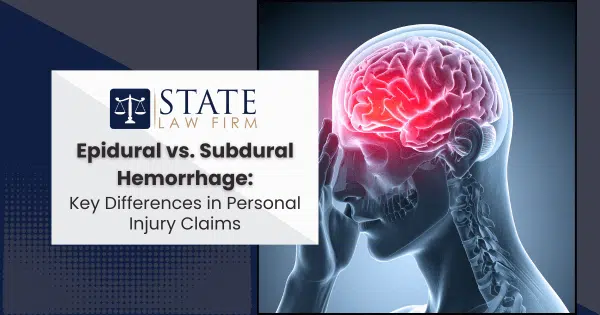Head trauma can lead to bleeding inside the skull that requires urgent care and has lifelong legal and financial consequences.
Two common types are epidural hemorrhage and subdural hemorrhage.
Understanding how they differ medically and why those differences matter in a personal injury case helps you move quickly, gather the right evidence, and protect your claim.
What Makes These Hemorrhages Different
Where the blood collects.
An epidural hemorrhage forms between the inner surface of the skull and the tough outer membrane that covers the brain, called the dura mater. A subdural hemorrhage forms between the dura mater and the arachnoid layer that lies closer to the brain. That anatomical difference drives how they look on scans, how they develop over time, and how they are treated.
Typical source of bleeding.
Epidural hemorrhage often involves arterial bleeding, classically from the middle meningeal artery after a skull fracture. Subdural hemorrhage most often comes from torn bridging veins that span from the brain surface to the dura, which can rupture during rapid acceleration or deceleration.
How they appear on CT.
Epidural hemorrhage typically looks like a lentil or lens that bulges inward, limited by the skull sutures. Subdural hemorrhage usually looks like a crescent that can spread over a larger area of the brain and may cross sutures, but is limited by the midline dural structures.
Time course and symptoms.
Epidural bleeding can appear after a short period of seeming normality called a lucid interval followed by rapid decline, which is a medical emergency. Subdural bleeding can appear acutely after a major impact or evolve slowly over days to weeks, especially in older adults or people on blood thinners, with symptoms like worsening headache, confusion, imbalance, or speech changes.
Why does this matter in a claim?
The type of hemorrhage shapes the narrative of causation and damages. An epidural injury often indicates a focused blow with skull fracture and a narrow window for life-saving surgery. A subdural injury may support a mechanism of whiplash or rotational forces with prolonged recovery and cognitive deficits. These differences affect liability theories, future care projections, and settlement ranges.
Actionable guidance
- Ask treating providers for copies of all head CT and MRI reports and the radiology images, not just discharge summaries.
- Keep a clear timeline of symptoms from the moment of impact through follow-up care.
- Document any blood thinners, alcohol use, or prior head injuries, since defendants may try to blame them.
- If there was a fall or vehicle crash, photograph the scene, vehicle damage, and any visible head injury as soon as possible.
Medical Red Flags to Recognize and Document
Immediate danger signs.
Loss of consciousness at the scene, a period of seeming recovery followed by worsening drowsiness or confusion, one pupil larger than the other, repeated vomiting, or a rapidly escalating headache require emergency evaluation. With epidural hemorrhage, deterioration can be sudden. With subdural hemorrhage, subtle changes can evolve, including personality shifts or slowed thinking.
Imaging and hospital records that matter.
Emergency department notes, Glasgow Coma Scale scores, neuro checks, and radiology interpretations of CT or MRI are key. For epidural hemorrhage, operative notes and postoperative scans show the extent of bleeding and the results of evacuation. For subdural hemorrhage, serial scans can demonstrate expansion or recurrence, which is common in chronic cases.
Functional impacts that often get missed.
Cognitive fatigue, light sensitivity, sleep disruption, slowed processing speed, and balance issues can linger even after the bleeding is controlled. These symptoms affect return to work and activities of daily living. Capturing them with neuropsychological testing, vestibular rehabilitation records, or employer documentation supports both pain and suffering and future economic loss.
Actionable guidance
- Request the radiology CDs along with DICOM viewers so your legal team can consult with a neuroradiology expert.
- Keep a symptom diary focused on cognitive endurance, headache severity, and triggers.
- Ask your providers about formal neuropsychological testing and referrals for vestibular or vision therapy.
- Save all work restrictions, missed time logs, and accommodation requests from your employer.
Common Accident Scenarios and Liability Angles
Vehicle crashes.
Side impacts, head strikes against pillars or windows, and abrupt deceleration can cause both types of hemorrhage. An epidural pattern may follow a localized impact with a skull fracture. A subdural pattern often aligns with rotational forces, even without direct head contact, which supports liability in rear-end or side-swipe cases where the defense claims the impact was minor.
Falls and premises incidents.
A fall from standing can cause a subdural hemorrhage in older adults due to stretched bridging veins. Poor lighting, unsafe stairs, or a lack of handrails strengthen negligence arguments. Outdoor falls may involve uneven pavement or potholes, leading to municipal or property owner liability with strict notice and claim deadlines.
Sports and workplace injuries.
Contact sports and construction sites involve high-energy mechanisms, including helmet or hard hat strikes. Failure to enforce safety rules, provide protective gear, or secure loads can move a case from simple negligence toward gross negligence, which affects damages in some jurisdictions.
Actionable guidance
- Secure video and black box data rapidly in motor vehicle cases, since retention windows are short.
- Send preservation letters to property owners and insurers for surveillance footage and incident reports.
- Obtain product manuals, training logs, and safety policies in workplace and sports cases to link the mechanism to breach of duty.
- Explore municipal notice requirements early in premises cases to avoid procedural bars.
Proving Causation and Damages for Each Hemorrhage Type
Building the medical bridge.
For epidural hemorrhage, tie the skull fracture and arterial bleed to a focused impact event, such as head contact with a door frame or steering wheel. For subdural hemorrhage, emphasize acceleration and rotational forces that tear bridging veins, supported by biomechanical analysis when needed. Emergency room timing, witness testimony, and consistent symptom progression are crucial.
Dealing with defense arguments.
Defendants often blame age, alcohol, preexisting brain atrophy, or anticoagulant use. These factors can increase vulnerability but do not break causation when the trauma precipitates the bleed. Treating physician testimony and literature about trauma thresholds help rebut alternative explanations.
Valuing future care.
Epidural cases may involve a single lifesaving surgery with relatively quick improvement, although deficits can persist. Subdural cases may require repeat evacuations, subdural drains, or long rehabilitation with cognitive therapy. Life care plans should include neuro follow-ups, imaging, medications for headache and mood, therapy services, and accommodations at school or work.
Economic loss and non-economic harm.
Document wage loss through payroll records and supervisor statements. For persistent cognitive issues, vocational assessments quantify lost earning capacity. Non-economic damages include pain, suffering, and loss of enjoyment of life. Family members may also have derivative claims where allowed.
Actionable guidance
- Ask treating neurosurgeons to state within medical records how the trauma caused the hemorrhage and why alternative causes are unlikely.
- Retain a neuroradiologist to explain how CT and MRI findings fit the mechanism.
- Use a vocational expert and economist to quantify long-term earning impacts when cognitive deficits persist.
- Organize exhibits that compare serial imaging to show resolution or recurrence over time.
Working With the Right Team and Taking Next Steps
Choose counsel experienced with brain injury medicine and litigation.
TBI cases require coordination among neurosurgeons, neuroradiologists, neuropsychologists, and life care planners. Your lawyer should know which experts to retain, how to secure medical records quickly, and how to present imaging and symptom timelines clearly to insurers and juries.
Move fast to protect evidence and benefits.
Early legal help ensures preservation letters go out, benefits are coordinated, and claim forms and deadlines are met. If a governmental entity is involved, special notice rules may apply. If a product defect or workplace violation is suspected, involve technical experts early.
Actionable guidance
- Call an attorney as soon as head bleeding is suspected so evidence requests are not delayed.
- Set calendar reminders for claim notice deadlines and insurance reporting obligations.
- Consolidate all medical billing statements and explanation of benefits so lien resolution does not delay settlement.
- Explore short-term disability, FMLA, and workplace accommodation options with your employer.
Want deeper guidance specific to motor vehicle injuries?
Explore our practical overview of Car accident lawyers so you can move forward with confidence and avoid costly mistakes.
Epidural and subdural hemorrhages are both serious, but they differ in where bleeding occurs, how quickly symptoms evolve, how they appear on imaging, and what they mean for proof of causation and damages. The right documentation, the right clinical experts, and prompt legal action give you the best chance to recover the full value of your claim.


